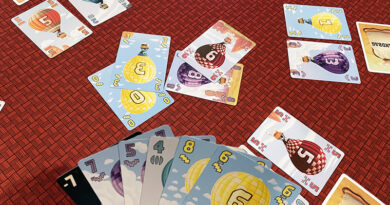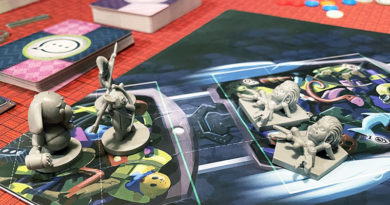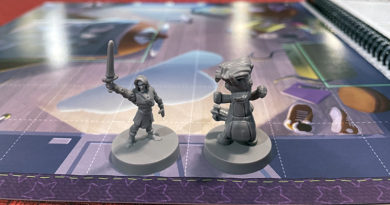Funfair Board Game Review
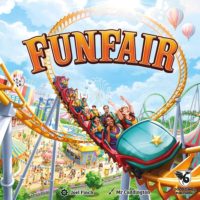
Funfair from Good Games Publishing is the follow up title to their award winning game — Unfair.
In Funfair players compete over 6 rounds to create the most popular theme park in town. They’ll build attractions like roller coasters, theaters, restaurants and a special Showcase. They can then upgrade those by adding exciting themes, guest services and features to make them more attractive to their customers.
The player to do this the best will be the next Walt Disney or maybe just the next winner of the game.
How to play Funfair
Setup:
To setup Funfair, players place the round coaster-token on the City step of the game board. Then they shuffle the various decks and place them in different areas.
- City cards: 6 cards are drawn off the top and the rest go back in the box. Keeping the 6 City cards facedown, players insert the “Blueprints Closed” card under the fourth card from the top and place the deck on the indicated position on the board.
- Awards cards: only 1 card is drawn and placed face-up on the Awards spot.
- Park cards: 5 cards are dealt to each player and 6 cards are placed face up on the board — creating the Market. The remainder make up a draw pile which is placed facedown on its indicated spot.
- Blueprints cards: the shuffled deck is placed facedown on its spot.
Players each take 1 Gate card, 1 Showcase card, a Reference card and 30 coins to begin.
The player who most recently rode a roller coaster gets the starting player token and the game is ready to begin.
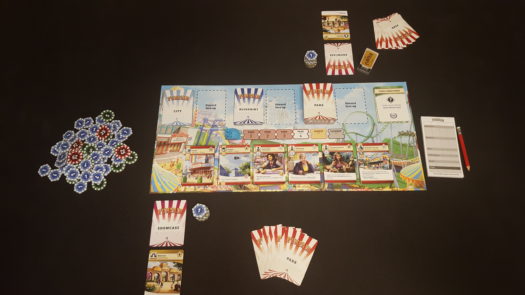
Gameplay:
The game is played over 6 rounds which have the following steps: City, Park, Guest, and Cleanup
City Step — Players turn over the top City card and follow its instructions. This could be an instant effect or an ongoing effect for the round.
Park Step — In turn order, players take one of the following actions 3 to 4 times (depending whether or not they have built their Showcase attraction):
- Build: A player may take a card from their hand OR the Market and place it in their park — paying the indicated number of coins to the supply. Note: There is a limit of five attractions per park which include the player’s Showcase attraction. The card played can be an attraction, upgrade or staff and might have a special ability when played.
- Take: A player may take 1 card from the Market and add it to their hand. Or draw 2 cards from the Park deck or Blueprint deck, choosing one to add to their hand and discarding the other. Or Discard one Park card from their hand, drawing 5 Park cards, keeping 1 (in their hand) and discarding the others.
- Loose change: Players may collect 1 coin for each attraction in their park. It pays to look under the upside-down rides.
- Demolish: A player may remove an attraction or upgrade from their park. However, if they demolish an attraction, all the upgrades attached to it are also removed.
Guest Step — Players add up all their stars from Attractions, Upgrades and Staff cards played into their parks and take that many coins from the supply. Players also add 5 coins to their Showcase cards if they haven’t yet built them. Such coins can only be used for building their Showcase attractions and not other Park cards.
Cleanup Phase — Discard all the Park cards from the Market and draw 6 new ones. Players discard down to their hand limit of 5 cards and move the starting player token to the next player.
The game ends when there are no City cards to turn over at the beginning of a round. Once this happens, players enter final scoring.
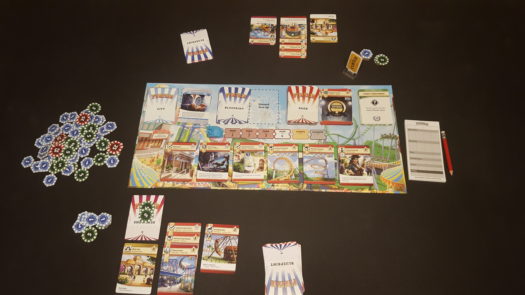
Final Scoring:
Final score is based on the value of the player’s Attractions, finished Blueprint cards, coins, staff members, and the Award card.
The value of a player’s Attraction is based on the number of icons associated with it. For example, Player A has 4 icons (attraction plus upgrades) on their 1st attraction, 3 on their next, and 5 on the last. They will score 16, 12, and 20 points respectively for the 3 attractions. There is a nice chart on the Reference card to remind players of this scoring.
Blueprints are then scored based on their completion. If the top part is complete, they will earn the listed points on the card. If the bottom of the card is finished, that player will earn the bonus points indicated. If a player doesn’t complete any of the Blueprint, they will lose 10 points.
Every 2 coins is worth 1 point.
Staff members offer a couple of scoring methods including a flat score and a number of points based on what the player has built into their park. For example 3 points for each Pirate themed ride.
Finally one player will earn the Award card by completing its objective. For example, building a park with the most theme icons.
The player with the most points wins!
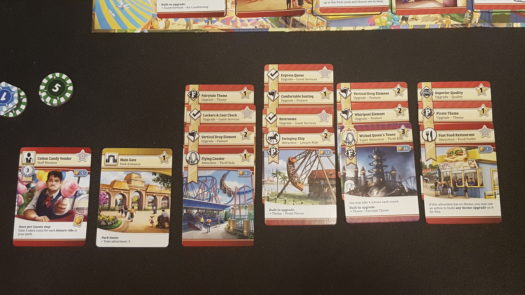
What we like about Funfair
When Funfair’s predecessor, Unfair, came out in 2017 I was very excited about it. I love the theme and the mechanics looked very cool. However I heard there was a lot of “Take That” in the game. For those unfamiliar with that term, according to BoardGameGeek.com it means “Competitive maneuvers that directly attack an opponent’s progress toward victory, but do not directly eliminate any characters or components representing the opponent”.
Due to this fact, I passed on getting the game, as that is one mechanic that doesn’t go over too well in my home. So when I heard that Funfair was coming out without that element, I was thrilled. It was dubbed the “friendly version” of Unfair, and that it is.
As I mentioned above, and in previous reviews, amusement parks are a theme I really enjoy. Probably because I played a lot of Roller Coaster tycoon when I was younger. The idea of building up an amusement park like Six Flags, Knott’s Berry Farm, or Disneyland is very appealing.
Although I’m not sure how I’d classify the mechanics of Funfair, the game play fits the theme like a glove. Players are building rides, upgrading them, improving their services, and completing objectives just like you might do for a real park. There’s a good amount of strategy in how you play the cards you are given and ways to mitigate the luck of the draw that can happen.
The artwork also ties everything in quite well.
Each attraction, upgrade, and staff card are beautifully illustrated by the very talented couple artists-Mr. Cuddington. I especially like the Showcase cards and their “too crazy to be real” feel.
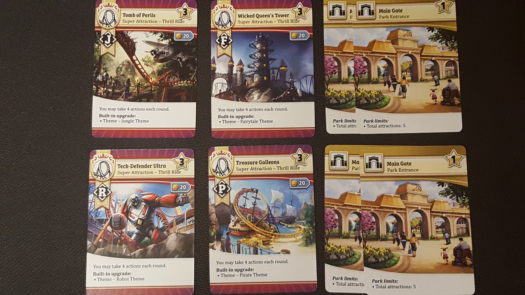
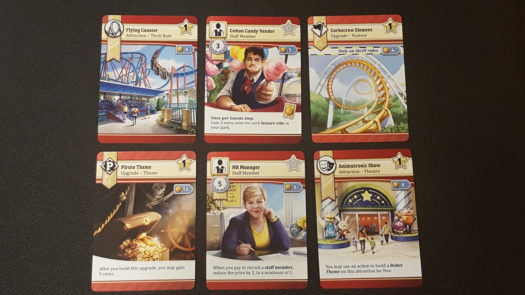
The quality of the components in Funfair are top notch. The cards, tokens, board, etc… are all great.
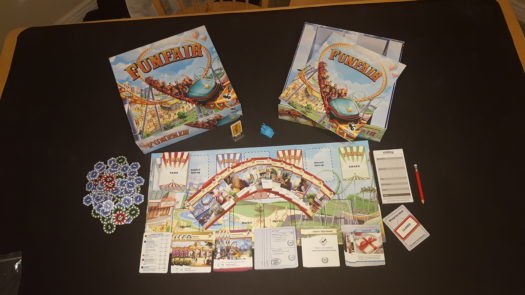
How does Funfair score on our “Let’s Play Again” game meter?
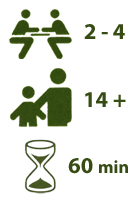 Funfair scores very high on our Let’s Play Again meter. It’s a light weight game that plays fairly quickly. Our first game took over an hour but subsequent games have been much faster. My two older boys were able to easily pick it up, while one of my younger ones had a little harder time but still enjoyed building his park.
Funfair scores very high on our Let’s Play Again meter. It’s a light weight game that plays fairly quickly. Our first game took over an hour but subsequent games have been much faster. My two older boys were able to easily pick it up, while one of my younger ones had a little harder time but still enjoyed building his park.
Between the theme, quick setup, light learning curve, and variable play (with the different City cards, Blue Print cards, and Award cards), I see this hitting the table a lot. Hopefully there will be some expansions in the future of Funfair.
About the Author
Dane is an Advertising and Layout Manager for a national magazine by day and a husband, father of four, and board gamer by night (and mornings). He has a passion for board games and believes board games help bring families closer together while providing kids a unique way to learn many diverse skills. And he thinks they are downright fun!!!
We’d like to thank Good Games Publishing for a review copy of Funfair.



